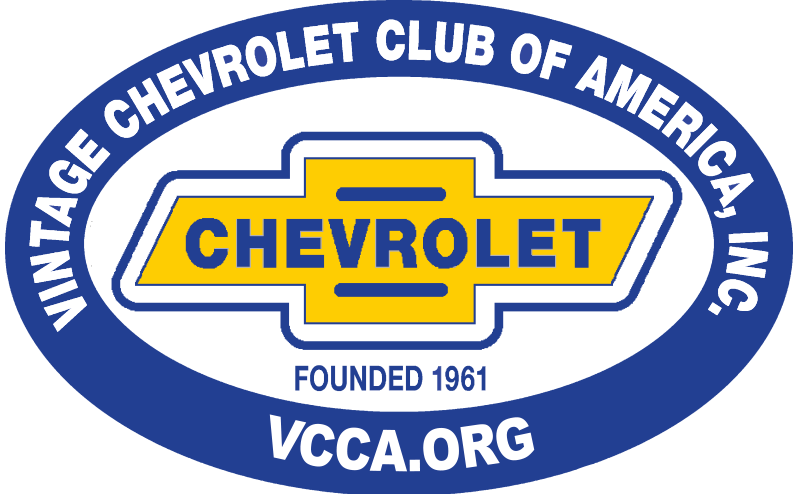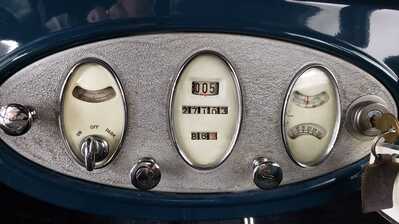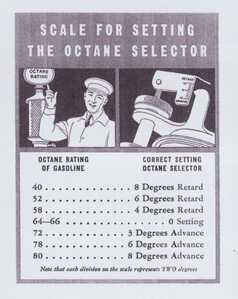I have recently acquired a 1929 Chevy ac and am baffled by not finding how to set the distributor timing in the service manual. I am not a good computer user and have tried to research the procedure on line.
Some searches have led me to find out that the timing specs are used up to a 1936. This is all fine and good, but there is no timing cover plate to remove to see the timing marks on the flywheel.
Where to start on the distributor timing?
Thanks you for your help.
Hi Paul
It's been a long time since I've done anything with my '29, and it's in the shed at the farm.
But I do have an operators manual at hand.
There is a small cover on the front face of the flywheel housing that opens to reveal a window with a pointer and timing marks on the flywheel.
The book says it's on the left side. I thought mine was on the right, but mine is a Canadian car, so that could be different.
Make sure the spark button is pushed all the way in.
Bring the engine up on compression on number 1 cylinder and line the 15 degree mark on the flywheel up with the pointer in the window.
Then loosen and rotate the distributor clockwise and then back counterclockwise until the points JUST open.
Tighten again.
That's the proper OLD timing setting.
Most people now add more advance for better performance and economy with today's gasoline (which is has a much higher octane rating than gas did in 1929).
Ole S Olson
Saskatoon, Sask, Canada
1946 DR 3/4 ton stake
1139 old site posts
Hi Stovbit,
Thank you for your helpful input.
OK, what is a spark button, what is its function in life, and where is it located?
Also, can you supply the name of the manual you are referring to so that I may acquire/search for a copy for my car’s records?
Homework tonight!! Paul
The manual is the "owners manual" like this one:
https://www.ebay.ca/itm/133382011006
Reprints can be purchased like for example this one:
https://store.fillingstation.com/detail/DG-A29/Chevrolet_1929_CAR_OWNERS_MANUAL.html
The spark button is the button to the right with "S" on it in this picture:
Ole S Olson
Saskatoon, Sask, Canada
1946 DR 3/4 ton stake
1139 old site posts
I forgot to mention that the spark button was meant to be pulled out enough to retard the spark when the engine was heavily loaded on hard up hill pulls etc to stop any knock caused by the low octane rating of gasoline at the time.
It took the place of the vacuum advance system which did not exist on 1929 Chevs but was added by Chev a few years later (1933 I think?).
Ole S Olson
Saskatoon, Sask, Canada
1946 DR 3/4 ton stake
1139 old site posts
Thanks Stovebit,
I found the timing marks as the original owner made a plate to cover them. I think it was to prevent having a mouse make a nest in the transmission. I am goind to try to retime the engine ignition again this weekend. Another question, how much back and forth movement is there on the distributor from moving retard to advance? There is only about 1/2 inch of play? Is this correct? thanks
Are you referring to the amount the distributor moves when the spark button is pulled out and pushed in?
If so... it's been a long time since I've done anything with my '29... but that sounds like it's probably about right.
When you loosen the clamp to adjust the timing however... you should be able to turn the distributor a lot more that.
Ole S Olson
Saskatoon, Sask, Canada
1946 DR 3/4 ton stake
1139 old site posts
I was loaned the National Service Manual and it has a wealth of information on early automobiles. This is what I discovered. I hope this will help other people in the club. Also, the timing explanation describes only a 15 degree movement of the distributor postion in retard to advance. I am use to a longer swing on the timing lever on earlier Chevrolets and got confused with such a small movement Paul
@paul-baresel On my 32 the original timing is 12 degrees BTC but I and many others find that around 18 degrees BTC works best due to todays higher octane gas. Should also note that plug gap has been increased to .040.
7472 old site post
I did more homework and found a thread on the old forums that is really detailed information and supports your experience. I am glad that there are many members that are willing to help out many beginners. Thanks
I forgot to include that I never thought of changing the timing due to the higher octaine gasoline. This is new experience for me.
A guide was printed back in the day for use with cars with an Octane Selector so they could adjust timing easily because of the variance in octane back then. When looking at the form you can see the octane of that era was quite low. Many times you can easily advance 10 degrees over stock without knock.
7046 old site posts
Save a life, adopt a senior shelter pet
There are many good people. If you can't find one, be one.
1938 Master Business Coupe
1953 210 Sedan
Update on my 1929 Chevy
Timing 12 degrees BTDC on compression stroke
Set spark plugs to .040
Cleaned and set point gap to .018
Drained old gas tank and using new gas with some Marvel Mystery oil. (We have ethanol gas in New England),
The engine started right up and let it warm up to readjust the carb fuel mixture and idle speed.
Drove car and performed much better with more power and minimal engine knock, nothing like it was before the tune up.
Can I advance the distributor timing with the engine running on idle by loosening the distributor lockdown clamp and slowly turning the distributor clockwise just a hair to advance the timing? I am hoping this will help to eliminate the ignition knock? Thanks for your help everyone.
In my experience it is not possible to have ignition knock on a 1931 engine at 12 deg. advance and 87 octane gas without significant carbon buildup on the pistons. Ignition knock happens when the high pressure from the burning fuel mixture happens before the piston reaches the top of its travel. The engine has 5:1 compression and was designed for 50 -60 octane fuel. The higher the octane number the slower the mixture burns. With the spark plugs in a pocket in the head the mixture tends to be lean. Lean mixtures take more energy (spark) to get the burn going. That is why the 0.040" spark plug gap helps. If there is significant carbon build up it becomes a burn initiation site that can be earlier than the spark plugs. Therefore ignition happens too early and the noise is produced. It also results in reduced power.
So my advise is to use a borescope to inspect the tops of the pistons for carbon deposits. There are some techniques to reduce carbon without taking the engine apart. I remember that ChevyGene posted on the old forum site. I didn't find it so maybe if Gene sees this post he will post it again.
How sweet the roar of a Chevy four
Participant on Chatter since 11/22/2001
19758 posts on the former Chatter site
Hi Paul
When exactly is this "spark knock" occurring?
If you are hearing this knock most or all of the time, it's not spark knock.
Spark knock should only occur under heavy acceleration or heavy loads.
You ask if you can rotate the distributor while the engine is running. The answer is yes you can.
Will "advancing" the timing eliminate spark knock? No it will not.
If it is spark knock you are experiencing, advancing will make it worse, retarding will make it better.
Combustion knock is caused by 2 different things, one being pre-ignition, the other being detonation.
As Chip has pointed out, pre-ignition is caused by hot spots (usually hot carbon deposits) that ignite the air/fuel mixture too far before TDC and the resulting extreme pressure build up causes the knock.
Detonation is what is typically referred to as "spark knock" and occurs when the mixture is ignited as and when it should be with a flame front advancing across the mixture in the combustion chamber. But... when the mixture is too unstable, the rising pressure and temperature in the combustion chamber causes the unburned part of the mixture ahead of the flame front to all suddenly spontaneously detonate at once, with the resulting extreme pressure rise again causing the knock you hear.
As Chip points out, detonation spark knock is almost impossible in a 1929 Chev engine with 87 octane gasoline.
That leaves pre-ignition due to hot carbon deposits, and that normally only occurs when the engine is hot and/or loaded.
All of this leads me to this question...
Are you absolutely sure you aren't hearing bearing knock or piston slap?
PS
Changing ignition timing WILL change the sound of both piston slap and bearing knock.
Ole S Olson
Saskatoon, Sask, Canada
1946 DR 3/4 ton stake
1139 old site posts




